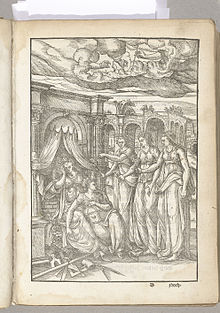Olyftack
| De Olyftack | |

An engraved representation of the blazon of the Olyftack at the 1561 rhetoric competition in Antwerp
|
|
| Motto | Ecce gratia |
|---|---|
| Formation | 1510 |
| Extinction | 1762 |
| Type | Chamber of rhetoric |
| Location | |
|
Region
|
Duchy of Brabant |
| Methods | amateur and semi-professional dramatic and recitative performance |
|
Membership (1615)
|
76 fee-paying members; 16 actors |
|
Official language
|
Dutch |
|
Honorary president
|
Hooftman |
|
Chairman
|
Prince |
|
Executive officer
|
Opperdeken |
|
Executive assistant
|
Mededeken |
|
Key people
|
Accoustrementmeester (properties master) Breuckmeesters (responsible for collecting membership fees) Busmeester (responsible for collecting alms for sick or "decayed" members) Princen van personagiën (casting directors) |
|
Staff
|
personagiën, confreers |
|
Volunteers
|
liefhebbers |
The Olyftack (Olive Branch), or in full Gulde van den Heyligen Geest die men noempt den Olyftack (Confraternity of the Holy Spirit called the Olive Branch) was a chamber of rhetoric that dates back to the early 16th century in Antwerp, when it was a social drama society drawing its membership primarily from merchants and tradesmen. In 1660 it merged with its former rival the Violieren (which was more closely associated with artists and intellectuals), and in 1762 the society was dissolved altogether.
The chamber took part in the landjuweel (a rhetoric competition for the whole Duchy of Brabant) at Mechelen in 1515, at Diest in 1521, at Brussels in 1532, at Mechelen in 1535, at Diest in 1541, and the final such competition, at Antwerp in 1561.
The chamber also provided public entertainment at such events as the triumphal entry into Antwerp of Alexander Farnese, Duke of Parma. During the 1590s there were no regular public performances, and for much of the decade meetings were prohibited by decree, but after 1600 members and sympathisers of the guild again began to meet weekly for dramatic and rhetorical exercises. During the Twelve Years' Truce, representatives of the Olyftack attended a rhetoric competition hosted in Amsterdam on 7 July 1613 by the Amsterdam chamber Wit Lavendel (White lavender), and another hosted in Haarlem by the Wyngaertranken (the Vines) on 18 August 1613. The organisation was overhauled in 1615. In 1618 the Olyftack hosted a blazoenfeest in Antwerp: a rhetoric competition in which chambers entered "blazons", or painted and decorated verse rebuses carried in procession, with prizes for best rhyme, best delivery, best painting, best decoration, best procession, and so on. In 1619 the chamber was deeply in debt, having overspent on banquets and performances.
They nevertheless took part in the blazoenfeest hosted by the Peoene (Peony) in Mechelen on 3 May 1620. Members of the Olyftack carried off second prize for best rhyming rebus, third prize for best painted rebus, third prize for most triumphant decoration, first prize for best composed verse, third prize for strongest line, first and second place for best recitation, first prize for best song, and second prize for most pieces entered by a single chamber.
For the play put on for the chamber's feestdag in 1621, 400 programmes were printed. The chamber was prominent in the civic celebrations of the Habsburg victories in the Battle of White Mountain (1620), the Battle of Stadtlohn (1623) and the Siege of Breda (1625), and for the ceremonies of public mourning for the death of Albert VII, Archduke of Austria in 1621.
...
Wikipedia
